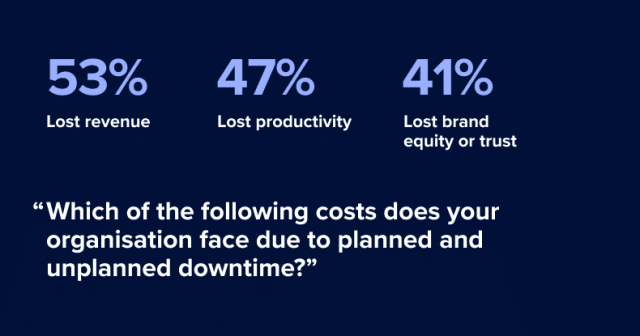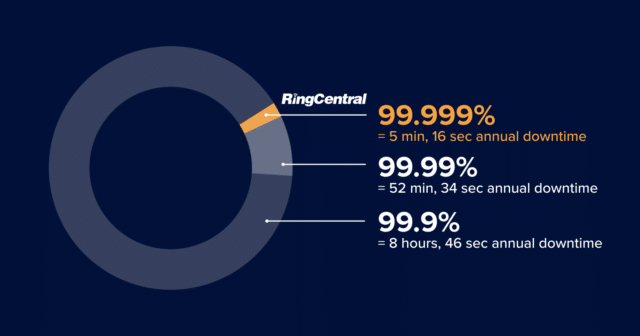When it comes to acquiring mission-critical applications, UK enterprises are willing to make huge investments. Think CRM, supply chain systems and project management tools.
Despite efforts invested in infrastructure reliability, many organisations continue to deal with downtime that lasts from a few minutes to several days, completely paralysing the business and causing irrecoverable losses. Especially in the context of COVID-19, where many businesses are fighting for their survival, the cost of an unexpected outage could mean the difference between closing your doors or remaining open for business.
Though unplanned outages are branded as “IT issues” they are, more importantly, revenue issues. Unplanned outages significantly reduce revenues for the company experiencing them. According to ITIC’s 2017 Reliability and Hourly Cost of Downtime Trends Survey, 47% of SMBs estimate that just one hour of downtime means £77,000 in lost revenue and end-user productivity. For large enterprises, these costs can climb into the millions, especially for data-driven industries like healthcare, finance, manufacturing, retail, transportation, and utilities. According to one IBM Global Services study, the average revenue cost of an unplanned application outage was estimated to be nearly £2.1 million pounds per hour. IT disruptions can affect the entire service chain of an organisation to their customers and community.

During unplanned downtime, IT leaders try to regain normality while minimising revenue impact — 49% of surveyed enterprises list data recovery as a top technical challenge, and 53% rank loss of revenue as a top business challenge of outages.

According to Dunn & Bradstreet, 59% of Fortune 500 companies experience a minimum of 1.6 hours of downtime per week. To put this in perspective, assume that an average Fortune 500 company has 10,000 employees who are paid an average of £56 per hour, including benefits. Just the labour component of downtime costs would be £896,000 weekly to the company, which translates into more than £46 million per year. The cost of each outage affects each company differently, so it’s important to know how to calculate the precise financial impact. Read how to quantify downtime to run your own businesses’ downtime impact model.
The scope of downtime per year

As Gartner has shown, downtime can reach 87 hours a year (for a large organisation). Obviously that’s the sum of many outages – anywhere from a few minutes to hours. But at the end of the day, for an organisation this becomes a staggering figure of lost revenue opportunities.
Average outage period

And when an outage occurs, it’s a race against time to handle it before it spirals out of control. According to the IT Process Institute, resolution time per outage is around 200 minutes.
Revenue impact from downtime
On average, businesses lose between £65,000 and £83,000 for every hour of IT system downtime, according to estimates from studies performed by IT industry analyst firms. In addition, financial services, telecommunications, manufacturing and energy lead the list of industries with a high rate of revenue loss during IT downtime.
If an outage creates a disruption in a supply chain with a high level of expectation in responsiveness (e.g. medical services or overnight delivery), the business may be exposed to even more damages. Often, damages stem from the inability to deliver (e.g. loss in delivery fees due to arriving late or lawsuits due to collateral damages). These highly publicised situations can impact shareholder value.

Reputation and loyalty impact from downtime
The sales-per-hour numbers do not include the value of customer loyalty. To more accurately assess total lost sales, the impact percentage must be increased to reflect the lifetime value of customers who permanently move to a competitor. If a large percentage of customers typically become very loyal after a satisfactory buying experience, the impact factor may significantly exceed 100%, possibly by a high multiple.
HR and customer impact from downtime
Downtime cost results in lost employee productivity, which can be measured in terms of the salaries, wages and benefits of idled people. After a downtime event, remedial actions are often required to repair the damage. For example, employees might work overtime – at overtime rates – or temporary staff may be contracted to recover lost data and enter accumulated paper transactions. If customer satisfaction was damaged, a costly special marketing programme may be necessary to win back customers.
Legal impact from downtime
Highly regulated industries like banking and finance, food, government, healthcare, and utilities must also factor in the potential losses related to litigation as well as civil penalties stemming from organisations’ failure to meet service level agreements (SLAs) or compliance regulations. Moreover, for a select 3% of organisations, whose businesses are based on high level data transactions, like banks and stock exchanges, online retail sales or even utility firms, losses may be calculated in millions of dollars per minute.
Downtime is a business burden: IT leaders must invest in solutions to reduce the impact
The overarching message is clear: downtime of even a few minutes is expensive and unwelcome. An ITIC study found that 81% of organisations now require a minimum of 99.99% availability. UK businesses must proactively work with their infrastructure and cloud vendors to ensure the inherent reliability of their systems, applications and networks. This is imperative as the industry moves to interconnected ecosystems. In the IBM study cited below, 63% of IT leaders said that they expect their organisation’s revenues to increase and it would increase their competitive advantage if they can achieve zero downtime.

2020 has seen IT executives dealing with major disruptions, and many are still uncertain about what IT will be like on the other side of the worldwide health crisis. That means using lessons learned from this real-life stress-test, and the need for resiliency and flexibility to ride through them. It is essential that IT leaders start now on future-fitting their organisations to prepare for a post-pandemic world. Thus, businesses must invest in technologies that will increase resiliency and help decrease both their planned and unplanned downtime. In return, IT leaders can then expect higher revenues and reduced business costs.
How can RingCentral help?
RingCentral is above the rest and can help you mitigate your downtime and availability concerns.

Five nines of reliability (99.999%) is the highest benchmark of system availability for business critical systems, networks, and software required by banking and other transaction-intensive industries. When you choose RingCentral, we provide you with the same high-quality service level. In technical terms, our data centers provide seven layers of failover redundancy that minimise service interruption in case of geographic outages or natural disasters. Our systems are also located in the same facilities as all major telecommunications carriers to maintain the fastest response times and interconnect services possible.
To avoid the challenges and risks from unplanned downtime, you can act now to develop a fully resourced plan, based on your specific needs to migrate to a reliable cloud solution. The current times present an opportunity for UK businesses to introduce new technologies for driving efficiencies, reliability, and ultimately lowering costs. The preparation and planning in the near-term will increase chances of long-term success in adapting to this new era, as well as reduce the likelihood of being caught with unplanned downtime when the economy swings back and the stakes are high.
Originally published Nov 23, 2020, updated Jul 13, 2021

